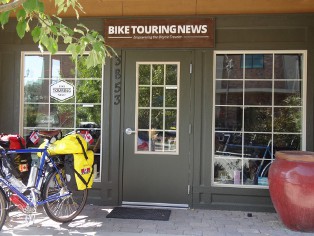On The Bike is a bike fit service collaborating with Boise State University’s Center for Orthopaedic and Biomechanics Research. We met Benjamin Stein, the man behind On The Bike when he stopped into Bike Touring News World Headquarters (BTNWH) a few months ago. We asked if we could come see his operation and write a blog post about it and he graciously offered a complimentary fit session to me.
Even though I have read almost everything I can find on the subject and I am trained in a prominent “laser precision bike fitting” system, I am not a bike fitting professional. That does not prevent me from holding forth on the subject in my series of articles on bike fit. What I do know is that riding a bike efficiently is neither simple nor intuitive… there are a lot of moving parts and we simply can’t tell what our own bodies are doing. But the cyclo-tourist needs to be able to ride efficiently and in comfort for long periods, and while I’m not saying that a professional bike fit is required for bike touring, a set of trained and critical eyes can help identify changes that might need to be made to improve enjoyment and to prevent injury.
On The Bike’s approach to fitting a rider on the bike seems to be holistic. Beginning with an interview, Ben gets a feeling for the person’s history and their goals. Then he observes as they perform a range of prescribed activities including knee bends, squats and simply walking. Then, with the rider flat on his/her back Ben assesses flexibility and looks for asymmetries or discrepancies in leg length and so on. Then reflective dots are affixed to strategic locations on the riders body. These dots will be picked up by the 8 motion capture video cameras arrayed around the bike, which is on a stationary trainer. As the rider rides, a computer compiles all the motion capture information and displays a 3-D video representation of the rider- a representation of the skeleton of the rider actually. Using this video Ben can confirm how any asymmetries affect the rider’s pedaling motion and he can see other issues which might be important but cannot be seen in a static view.
As I was pressing Ben for formulas or rules of thumb he might use for things such as saddle height or crank length it became apparent that he didn’t have any dogmatic rules or guidelines… which I can appreciate, since no two people are exactly the same. With his background in physiology (Ben holds an M. S. degree in Exercise Physiology with a bio-mechanics emphasis) he can see how a rider’s body interfaces with the bike and make recommendations on how to achieve a better range of motion or better use of a muscle group.
I came away with a better understanding of just how complicated achieving a comfortable, efficient position on the bike can be. All those moving parts need to work together and changing one component, simply moving the saddle forward for example, changes the relationships of all the other parts. That recognition and appreciation may be one of the values of what Ben Stein is trying to do with On The Bike. When he then makes suggestions or observations based on his background and experience it can help the rider understand the reasoning and be more aware of what their body is doing.
To the person considering getting fit on a touring bike I would say; Beware of formulaic, rigid bike fitting “systems” and quickly move away from anybody who claims they can provide the “perfect” fit for you on the first try. Most of these people focus on performance or racing. Racers and tourist have different needs. The tourist will not be sprinting or trying to cheat the wind to go faster and their touring bike has a different geometry than a racing bike- plus it will be loaded, and so it will handle differently. Somebody like Ben who knows enough about physiology to be flexible in their approach will be best for the touring cyclist.

Bert Fox April 17, 2013, 5:06 pm
Can you email me contact info for “On the Bike”?
Sky King May 8, 2013, 1:02 pm
Bert, simply click on the link in the post. http://www.onthebikeidaho.com/ is Ben’s website